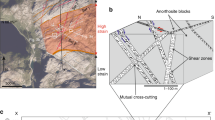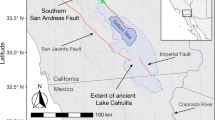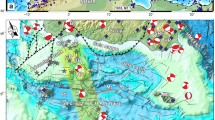Abstract
The spatiotemporal behaviour of earthquakes within continental plate interiors is different from that at plate boundaries. At plate margins, tectonic motions quickly reload earthquake ruptures, making the location of recent earthquakes and the average time between them consistent with the faults’ geological, palaeoseismic and seismic histories. In contrast, what determines the activation of a particular mid-continental fault and controls the duration of its seismic activity remains poorly understood1. Here we argue that the concentration of magnitude-7 or larger earthquakes in the New Madrid seismic zone of the central United States2,3 since the end of the last ice age results from the recent, climate-controlled, erosional history of the northern Mississippi embayment. We show that the upward flexure of the lithosphere caused by unloading from river incision between 16,000 and 10,000 years ago caused a reduction of normal stresses in the upper crust sufficient to unclamp pre-existing faults close to failure equilibrium. Models indicate that fault segments that have already ruptured are unlikely to fail again soon, but stress changes from sediment unloading and previous earthquakes may eventually be sufficient to bring to failure other nearby segments that have not yet ruptured.
This is a preview of subscription content, access via your institution
Access options
Subscribe to this journal
Receive 51 print issues and online access
$199.00 per year
only $3.90 per issue
Buy this article
- Purchase on Springer Link
- Instant access to full article PDF
Prices may be subject to local taxes which are calculated during checkout




Similar content being viewed by others
References
Crone, A. J., De Martini, P. M., Machette, M. N., Okumura, K. & Prescott, J. R. Paleoseismicity of two historically quiescent faults in Australia: implications for fault behavior in stable continental regions. Bull. Seismol. Soc. Am. 93, 1913–1934 (2003)
Johnston, A. C. Seismic moment assessment of earthquakes in stable continental regions. III. New Madrid 1811–1812, Charleston 1886, and Lisbon 1755. Geophys. J. Int. 126, 314–344 (1996)
Hough, S. E., Armbuster, J. G., Seeber, L. & Hough, J. F. On the modified Mercalli intensities and magnitudes of the 1811–1812 New Madrid earthquakes. J. Geophys. Res. 105, 23839–23864 (2000)
Tuttle, M. et al. The earthquake potential of the New Madrid seismic zone. Bull. Seismol. Soc. Am. 92, 2080–2089 (2002)
Newman, A. et al. Slow deformation and lower seismic hazard at the New Madrid seismic zone. Science 284, 619–621 (1999)
Calais, E. & Stein, S. Time-variable deformation in the New Madrid seismic zone. Science 323, 1442 (2009)
Van Arsdale, R. B. Displacement history and slip rate on the Reelfoot fault of the New Madrid seismic zone. Eng. Geol. 55, 219–226 (2000)
Calais, E., Han, J. Y., DeMets, C. & Nocquet, J. M. Deformation of the North American plate interior from a decade of continuous GPS measurements. J. Geophys. Res. 111, B06402 (2006)
Grollimund, B. & Zoback, M. D. Did deglaciation trigger intraplate seismicity in the New Madrid seismic zone? Geology 29, 175–178 (2001)
Wu, P. & Johnston, P. Can deglaciation trigger earthquakes in North America? Geophys. Res. Lett. 27, 1323–1326 (2000)
McKenna, J., Stein, S. & Stein, C. A. Is the New Madrid seismic zone hotter and weaker than its surroundings? Spec. Pap. Geol. Soc. Am. 425, 167–175 (2007)
Grana, J. P. & Richardson, R. M. Tectonic stress within the New Madrid seismic zone. J. Geophys. Res. 101, 5445–5458 (1996)
Pollitz, F. F., Kellogg, L. & Burgmann, R. Sinking mafic body in a reactivated lower crust: a mechanism for stress concentration at the New Madrid seismic zone. Bull. Seismol. Soc. Am. 91, 1882–1897 (2001)
Kenner, S. J. & Segall, P. A mechanical model for intraplate earthquakes: application to the New Madrid seismic zone. Science 289, 2329–2332 (2000)
Van Arsdale, R., Bresnahan, R., McCallister, N. & Waldron, B. Upland Complex of the central Mississippi River valley: its origin, denudation, and possible role in reactivation of the New Madrid seismic zone. Geol. Soc. Am. Spec. Pap. 425, 77–192 (2007)
Rittenour, T. M., Blum, M. D. & Goble, R. J. Fluvial evolution of the lower Mississippi River valley during the last 100 k.y. glacial cycle: response to glaciations and sea-level change. Geol. Soc. Am. Bull. 119, 586–608 (2007)
Mueller, K., Hough, S. E. & Bilham, R. Analysing the 1811–1812 New Madrid earthquakes with recent instrumentally recorded aftershocks. Nature 429, 284–287 (2004)
Freed, A. M. Earthquake triggering by static, dynamic, and postseismic stress transfer. Annu. Rev. Earth Planet. Sci. 33, 335–367 (2005)
Townend, J. & Zoback, M. D. How faulting keeps the crust strong. Geology 28, 399–402 (2000)
Baldwin, J. N. et al. Constraints on the location of the late Quaternary Reelfoot and New Madrid North faults in the northern New Madrid seismic zone, central United States. Seismol. Res. Lett. 6, 772–789 (2005)
Guccione, M. J., Marple, R. & Autin, W. J. Evidence for Holocene displacements on the Bootheel fault (lineament) in southeastern Missouri: seismotectonic implications for the New Madrid region. Geol. Soc. Am. Bull. 117, 319–0333 (2005)
Cox, R. T., Harris, J., Larsen, J. B., Van Arsdale, R. B. & Forman, S. L. Paleoseismology of the southeastern Reelfoot Rift in western Tennessee and implications for intraplate fault zone evolution. Tectonics 25, TC3019 (2006)
Freed, A. M., Ali, S. T. & Bürgmann, R. Evolution of stress in Southern California for the past 200 years from coseismic, postseismic and interseismic stress changes. Geophys. J. Int. 169, 1164–1179 (2007)
Freed, A. M., Bürgmann, R., Calais, E., Freymueller, J. & Hreinsdottir, S. Implications of deformation following the 2002 Denali, Alaska, earthquake for postseismic relaxation processes and lithospheric rheology. J. Geophys. Res. 111, B01401 (2006)
Allmann, B. P. & Shearer, P. M. Global variations of stress drop for moderate to large earthquakes. J. Geophys. Res. 114, B01310 (2009)
Li, Q., Liu, M. & Stein, S. Spatial-temporal complexity of continental intraplate seismicity: insights from geodynamic modeling and implications for seismic hazard estimation. Bull. Seismol. Soc. Am. 99, 52–60 (2009)
Karato, S. I. in Earth’s Deep Interior (ed. Croosley, D.) 223–272 (Gordon and Breach, 1997)
Carter, N. L. & Tsenn, M. C. Flow properties of continental lithosphere. Tectonophysics 136, 27–63 (1987)
Kirby, S. H. & Kronenberg, A. K. Rheology of the lithosphere; selected topics. Rev. Geophys. 25, 1219–1244 (1987)
Liu, L. & Zoback, M. D. Lithospheric strength and intraplate seismicity in the New Madrid seismic zone. Tectonics 16, 585–595 (1997)
Acknowledgements
This work was partly supported by the US Geological Survey through the Department of the Interior, under USGS award number 07HQGR0049. We thank M. Zoback for his comments.
Author information
Authors and Affiliations
Contributions
E.C. designed the study and prepared the main manuscript, with contributions from all co-authors. A.M.F. performed the modelling tasks and wrote Methods. R.V.A. provided the geological information. S.S. provided background context for the study. All authors discussed the results and implications and commented on the manuscript at all stages.
Corresponding author
Ethics declarations
Competing interests
The authors declare no competing financial interests.
Supplementary information
Supplementary Information
This file contains Supplementary Tables S1-S2, Supplementary Figures S1-S3 with legends and References. (PDF 221 kb)
Rights and permissions
About this article
Cite this article
Calais, E., Freed, A., Van Arsdale, R. et al. Triggering of New Madrid seismicity by late-Pleistocene erosion. Nature 466, 608–611 (2010). https://doi.org/10.1038/nature09258
Received:
Accepted:
Issue Date:
DOI: https://doi.org/10.1038/nature09258
This article is cited by
-
Gravity-induced seismicity modulation on planetary bodies and their natural satellites
Scientific Reports (2024)
-
Identifying Potential Earthquake Sources in Continental Environments
Surveys in Geophysics (2022)
-
Airborne geophysical surveys of the lower Mississippi Valley demonstrate system-scale mapping of subsurface architecture
Communications Earth & Environment (2021)
-
Earthquake statistics changed by typhoon-driven erosion
Scientific Reports (2020)
-
An updated stress map of the continental United States reveals heterogeneous intraplate stress
Nature Geoscience (2018)
Comments
By submitting a comment you agree to abide by our Terms and Community Guidelines. If you find something abusive or that does not comply with our terms or guidelines please flag it as inappropriate.



